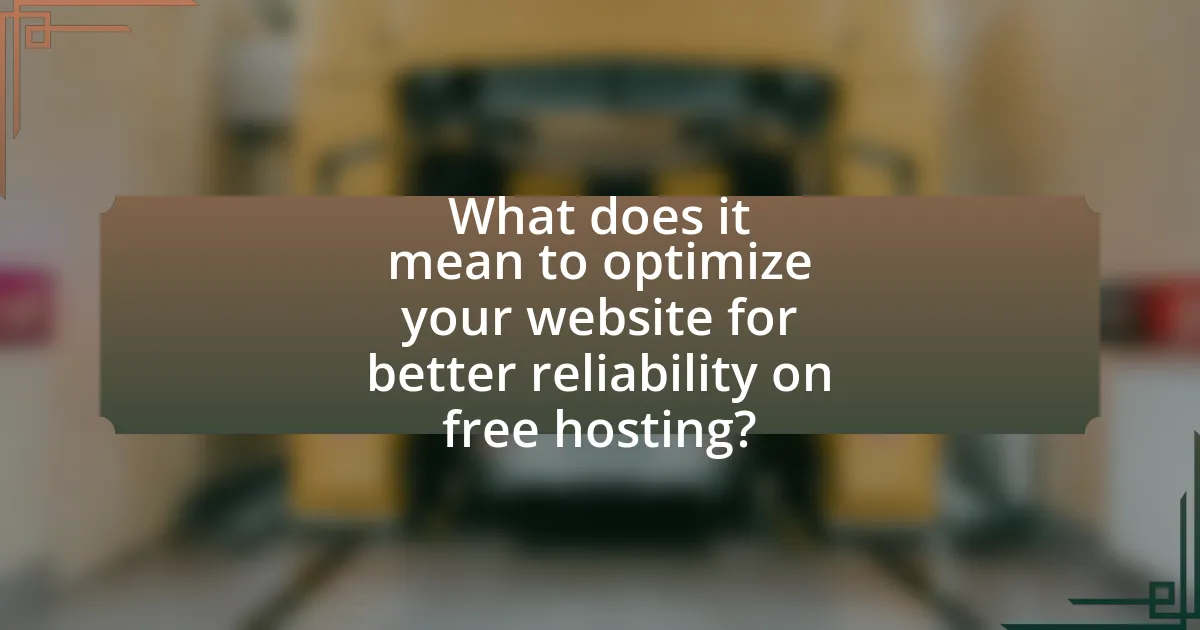Optimizing your website for better reliability on free hosting involves implementing strategies that enhance performance, uptime, and user experience despite inherent limitations. Key factors influencing website reliability include server uptime, bandwidth restrictions, and customer support availability. Techniques such as optimizing images, utilizing caching, and employing content delivery networks (CDNs) can significantly improve load times and reduce downtime. Additionally, regular monitoring of website performance and implementing best practices for data management are crucial for maintaining a dependable online presence. Understanding the common pitfalls of free hosting and adopting effective troubleshooting methods further contribute to a reliable website experience.

What does it mean to optimize your website for better reliability on free hosting?
Optimizing your website for better reliability on free hosting means implementing strategies that enhance performance, uptime, and user experience despite the limitations of free hosting services. This includes minimizing resource usage by optimizing images and scripts, utilizing caching techniques to reduce load times, and ensuring that the website’s code is clean and efficient. Additionally, regularly monitoring website performance and uptime can help identify issues early, allowing for timely adjustments. According to a study by Google, a one-second delay in page load time can lead to a 20% decrease in conversions, highlighting the importance of optimization for maintaining user engagement and reliability.
How does website reliability impact user experience?
Website reliability significantly enhances user experience by ensuring consistent access and functionality. When a website is reliable, users encounter fewer errors, faster load times, and uninterrupted service, which fosters trust and satisfaction. Research indicates that 47% of users expect a web page to load in two seconds or less, and 40% abandon a site that takes more than three seconds to load. Therefore, reliable websites not only retain users but also encourage repeat visits, ultimately leading to higher engagement and conversion rates.
What factors contribute to website reliability on free hosting?
Website reliability on free hosting is influenced by factors such as server uptime, bandwidth limitations, customer support, and security measures. Server uptime is critical; many free hosting services offer limited uptime guarantees, which can lead to frequent downtimes. Bandwidth limitations can restrict the amount of traffic a website can handle, affecting its accessibility. Customer support is often minimal or non-existent in free hosting, making it difficult to resolve issues quickly. Lastly, security measures are typically less robust, increasing vulnerability to attacks and data loss. These factors collectively determine how dependable a website will be when hosted on a free platform.
How can downtime affect your website’s performance?
Downtime negatively impacts a website’s performance by causing unavailability, which leads to lost traffic and potential revenue. When a website is down, users cannot access content or services, resulting in immediate user frustration and abandonment. According to a study by Gartner, even a single hour of downtime can cost businesses up to $300,000, highlighting the financial implications. Additionally, prolonged downtime can harm search engine rankings, as search engines may lower the site’s visibility due to poor reliability. This combination of lost user engagement and diminished search presence underscores the critical importance of maintaining uptime for optimal website performance.
Why is free hosting often less reliable than paid options?
Free hosting is often less reliable than paid options due to limited resources and support. Free hosting services typically allocate fewer server resources, leading to slower performance and increased downtime. For instance, a study by HostingAdvice found that free hosting providers often experience higher downtime rates, averaging around 20% compared to less than 1% for reputable paid services. Additionally, free hosting often lacks customer support, which can exacerbate issues when they arise, leaving users without timely assistance. This combination of resource limitations and inadequate support contributes to the overall unreliability of free hosting compared to paid alternatives.
What limitations do free hosting services typically impose?
Free hosting services typically impose limitations such as restricted bandwidth, limited storage space, and lack of customer support. These constraints can hinder website performance and user experience, as bandwidth restrictions may lead to slow loading times during high traffic, while limited storage can restrict the amount of content hosted. Additionally, the absence of customer support can complicate troubleshooting and maintenance, leaving users without assistance when issues arise.
How do resource allocation and server performance differ in free hosting?
Resource allocation in free hosting typically involves limited CPU, RAM, and bandwidth, while server performance often suffers due to overcrowded servers and shared resources. In free hosting environments, providers allocate minimal resources to each user to accommodate a larger number of accounts, which can lead to slower response times and increased downtime. For instance, many free hosting services impose strict limits on data transfer and storage, resulting in degraded performance during peak usage times. This contrasts with paid hosting, where dedicated resources enhance server performance and reliability.

What strategies can you implement to enhance website reliability on free hosting?
To enhance website reliability on free hosting, implement strategies such as optimizing website performance, utilizing a content delivery network (CDN), and regularly backing up data. Optimizing website performance involves minimizing file sizes, reducing HTTP requests, and leveraging browser caching, which can significantly improve load times and reduce downtime. Utilizing a CDN distributes content across multiple servers, ensuring faster access and reducing the risk of server overload. Regularly backing up data protects against data loss, allowing for quick recovery in case of server issues. These strategies collectively contribute to a more reliable website experience on free hosting platforms.
How can you choose the right free hosting provider?
To choose the right free hosting provider, evaluate the provider’s uptime reliability, bandwidth limits, and customer support options. Uptime reliability is crucial as it indicates how often the server is operational; a provider with at least 99.9% uptime is generally considered reliable. Bandwidth limits affect how much traffic your website can handle; select a provider that offers sufficient bandwidth for your expected visitor volume. Additionally, assess customer support availability, as responsive support can resolve issues quickly, ensuring your website remains functional. Research shows that providers with strong uptime records and responsive support lead to better website performance and user satisfaction.
What features should you look for in a reliable free hosting service?
A reliable free hosting service should offer features such as uptime guarantees, bandwidth limits, storage capacity, customer support, and security measures. Uptime guarantees ensure that your website remains accessible, with a standard expectation of 99.9% uptime. Bandwidth limits dictate how much data can be transferred, which is crucial for handling traffic without slowdowns. Storage capacity determines how much content you can host, impacting your website’s scalability. Customer support is essential for resolving issues quickly, and reliable services often provide 24/7 assistance. Security measures, including SSL certificates and regular backups, protect your website from threats and data loss. These features collectively contribute to a dependable hosting experience, as evidenced by user reviews and industry comparisons that highlight the importance of these elements in maintaining website performance and security.
How can user reviews and ratings guide your choice?
User reviews and ratings can significantly guide your choice by providing insights into the experiences of others with a specific service or product. These reviews often highlight the strengths and weaknesses of free hosting options, allowing potential users to make informed decisions based on real-world feedback. For instance, a study by BrightLocal found that 91% of consumers read online reviews, and 84% trust them as much as personal recommendations. This data underscores the importance of user-generated content in evaluating the reliability of free hosting services, as consistent positive ratings can indicate a trustworthy provider, while negative reviews may signal potential issues.
What technical optimizations can improve your website’s reliability?
Implementing a Content Delivery Network (CDN) significantly enhances website reliability by distributing content across multiple servers globally, reducing latency and server load. CDNs improve uptime and speed, as they can handle traffic spikes and provide redundancy. According to a study by Akamai, websites using CDNs experience up to 50% faster load times and 99.9% uptime, demonstrating the effectiveness of this optimization. Additionally, optimizing images and leveraging browser caching can further enhance reliability by decreasing load times and server requests, ensuring a smoother user experience.
How can you optimize your website’s code for better performance?
To optimize your website’s code for better performance, minimize file sizes by compressing images and using minified CSS and JavaScript. This approach reduces load times, as smaller files require less bandwidth and processing power. For instance, using tools like Gzip for compression can decrease file sizes by up to 70%, significantly enhancing page speed. Additionally, implementing asynchronous loading for JavaScript files prevents render-blocking, allowing the webpage to load faster. According to Google’s PageSpeed Insights, optimizing code can lead to improved user experience and higher search engine rankings, as faster websites tend to retain visitors better and rank higher in search results.
What role does caching play in enhancing website reliability?
Caching significantly enhances website reliability by storing frequently accessed data, which reduces server load and improves response times. When a website utilizes caching, it minimizes the need for repeated database queries or server processing for the same content, leading to faster page load times and a smoother user experience. According to a study by Google, a one-second delay in page load time can lead to a 20% decrease in conversions, highlighting the importance of efficient data retrieval. Additionally, caching helps maintain website performance during traffic spikes, ensuring that users can access content without interruption, thereby reinforcing overall reliability.

What common pitfalls should you avoid when using free hosting?
When using free hosting, you should avoid pitfalls such as limited bandwidth, lack of customer support, and potential data loss. Limited bandwidth can lead to slow website performance and downtime, as many free hosting services impose strict limits on data transfer. Lack of customer support means that if issues arise, you may not receive timely assistance, which can hinder your website’s reliability. Additionally, free hosting services often do not guarantee data backups, increasing the risk of data loss. These factors can significantly impact your website’s performance and reliability, making it essential to carefully consider these pitfalls before choosing a free hosting option.
How can you prevent common issues associated with free hosting?
To prevent common issues associated with free hosting, users should choose a reputable provider that offers reliable uptime and customer support. Selecting a provider with a proven track record, such as those with at least 99.9% uptime guarantees, minimizes downtime and service interruptions. Additionally, regularly backing up website data ensures that users can quickly restore their sites in case of data loss, which is a frequent risk with free hosting services. Implementing security measures, such as using SSL certificates and keeping software updated, protects against vulnerabilities that can lead to hacking or data breaches.
What are the risks of using too many plugins or themes?
Using too many plugins or themes can lead to significant risks, including decreased website performance and increased security vulnerabilities. Each additional plugin or theme adds complexity, which can slow down loading times and negatively impact user experience. According to a study by WP Engine, websites with excessive plugins can experience up to a 50% increase in load time, leading to higher bounce rates. Furthermore, plugins and themes can introduce security flaws; a report from Sucuri indicates that 60% of website hacks are attributed to vulnerabilities in plugins. Therefore, managing the number of plugins and themes is crucial for maintaining optimal website reliability and security.
How can you manage bandwidth and storage limitations effectively?
To manage bandwidth and storage limitations effectively, implement data compression techniques and optimize media files. Data compression reduces the size of files, allowing more data to be transmitted over limited bandwidth, while optimized media files, such as images and videos, can significantly decrease storage usage and loading times. For instance, using formats like WebP for images can reduce file sizes by up to 30% without sacrificing quality. Additionally, utilizing content delivery networks (CDNs) can distribute bandwidth usage across multiple servers, enhancing access speed and reliability. According to a study by Akamai, websites that leverage CDNs can experience up to a 50% reduction in load times, which directly correlates with improved user experience and reduced bandwidth strain.
What best practices can you adopt for maintaining website reliability?
To maintain website reliability, implement regular backups, monitor uptime, and optimize performance. Regular backups ensure that data can be restored in case of failure, with best practices suggesting daily or weekly backups depending on site activity. Monitoring uptime through tools like UptimeRobot can help identify outages quickly, as studies show that websites with 99.9% uptime can significantly enhance user trust and engagement. Optimizing performance by minimizing load times through techniques such as image compression and leveraging browser caching can improve user experience, as research indicates that a one-second delay in page load time can lead to a 7% reduction in conversions.
How often should you back up your website on free hosting?
You should back up your website on free hosting at least once a week. Regular weekly backups help ensure that you can quickly restore your site in case of data loss or corruption. According to a study by the Online Backup Review, 60% of small businesses that experience data loss shut down within six months, highlighting the importance of consistent backups for website reliability.
What monitoring tools can help you track website performance?
Monitoring tools that can help track website performance include Google Analytics, GTmetrix, and Pingdom. Google Analytics provides insights into user behavior and site traffic, allowing for performance analysis. GTmetrix evaluates page load speed and offers recommendations for improvement, while Pingdom monitors uptime and response times, ensuring that the website is accessible. These tools are widely used in the industry, with Google Analytics having over 29 million websites utilizing its services, demonstrating their effectiveness in performance tracking.
What are some troubleshooting tips for common reliability issues on free hosting?
To troubleshoot common reliability issues on free hosting, first, check server uptime and response times using monitoring tools like UptimeRobot or Pingdom. These tools provide real-time data on server performance, helping identify outages or slow response times. Next, optimize website content by compressing images and minimizing code, as large files can slow down loading times and affect reliability. Additionally, ensure that your website is not exceeding bandwidth limits, which can lead to throttling or downtime; many free hosting services impose strict limits. Lastly, regularly update your website’s software and plugins to prevent security vulnerabilities that can compromise reliability. These steps are essential for maintaining a stable and reliable online presence on free hosting platforms.
How can you identify and resolve downtime quickly?
To identify and resolve downtime quickly, implement real-time monitoring tools that alert you to outages immediately. These tools, such as Pingdom or UptimeRobot, continuously check your website’s availability and notify you via email or SMS when downtime occurs. According to a study by the Aberdeen Group, companies that utilize monitoring solutions can reduce downtime by up to 50%, demonstrating the effectiveness of proactive monitoring in maintaining website reliability. Additionally, having a predefined response plan allows for swift action, such as restarting servers or contacting your hosting provider, ensuring minimal disruption to your services.
What steps should you take if your website is running slowly?
To address a slow website, first, assess the website’s performance using tools like Google PageSpeed Insights or GTmetrix. These tools provide specific metrics and recommendations for improvement. Next, optimize images by compressing them to reduce load times, as unoptimized images can significantly slow down a site. Additionally, minimize HTTP requests by reducing the number of elements on each page, which can enhance loading speed. Implementing browser caching can also improve performance, allowing repeat visitors to load pages faster. Finally, consider upgrading your hosting plan if the current free hosting service cannot meet your website’s traffic demands, as free hosting often has limitations that can affect speed.
